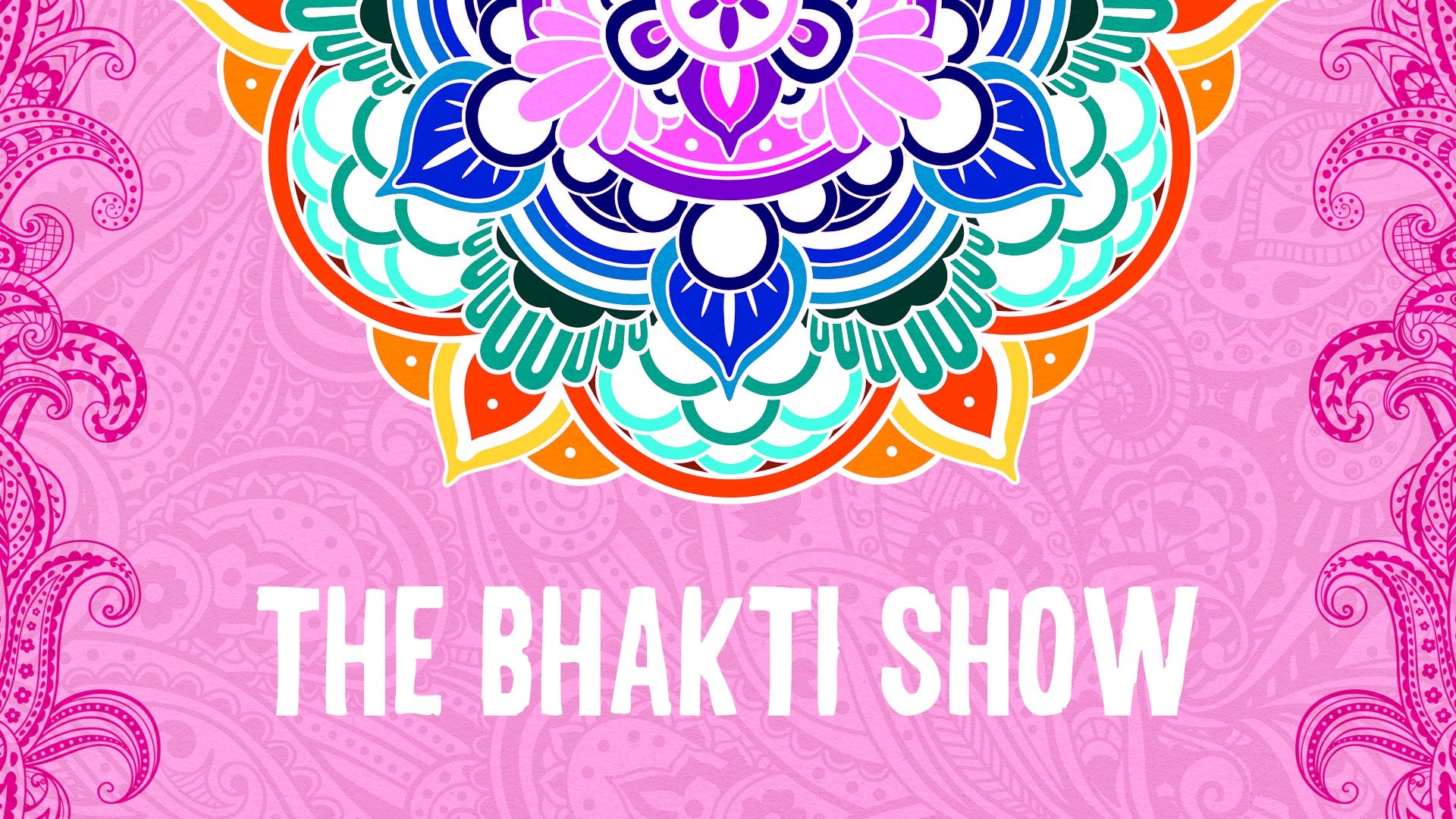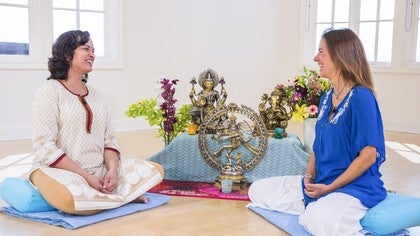Description
About This Video
Transcript
Read Full Transcript
Om Shreem Mahalakshmi Yena Maha Om Shreem Mahalakshmi Yena Maha Om Shreem Mahalakshmi Yena Maha Welcome to this introduction to Lakshmi. So Lakshmi is a beautiful Goddess. I'm so happy that we've just been talking about some of the Gods, Shiva and Ganesha, and now we get to open our awareness to one of the Goddesses of the Indian tradition of the yogic path. So Lakshmi is a beautiful blessing in our lives. She brings abundance, not only in the material world, but also of love, of joy, of happiness.
So thank you so much Manoj Chalam for enlightening us, illuminating our awareness and understanding of what Lakshmi can bring in our lives as we start to relate to her. And for the embodiment of Lakshmi, Jyoti, thank you so much for sharing a song with us to share that energy. It's my pleasure. Thank you. Thank you. Lakshmi. Now you would notice when Julia was speaking about Lakshmi, she was especially all glowing.
And that's because her archetype, Harishta Devata is Lakshmi. And Lakshmi is the Goddess of abundance. But I want to go back just a little bit because Julia used the word Hindu Gods and Goddesses a couple of times. I want to make one clarification. These deities are commonly perceived as a Hindu tradition.
But interestingly, the word Hindu did not exist in the Vedas until 1730. In fact, it did not exist in the Vedas at all. And the word Hinduism did not come from India. It's never been a religion. So there's a difference between a religious experience and a spiritual practice.
A spiritual practice is doing a set of practices to realize the self, be it meditation, chanting, etc. A religion is a belief. You believe there's a heaven hell or you don't. It's your personal belief. A spiritual experience is what you feel. You cannot deny what you feel when you meditate, when you dream, etc. Now, when the British came to India, that's where a connection with Julia, a very beautiful English woman comes in, is when the British came to India around the 17th century, they found the Indians engaged in different spiritual practices. And some Indians were meditating, some were chanting, some were doing asana, some tantrikas were smoking dope, which is now legal in California, but they were smoking dope in those days and thinking of Shiva.
And the British mind, you know, they come to India and they see all these people doing different practices and you can put yourself in the shoes of the British, which sees all this and they're coming from a monotheistic approach, right? One god. And they said not quite cricket, right? So, at that time, the people of the Indus Valley River were called Hindus by the Persian traders. So, the British coined the name Hinduism and made it a religion. And even the Indians bought into it. The point is Hinduism has never been a religion. It's called Sanatana Dharma, which is eternal living and it's a set of spiritual practices to realize the self. And interestingly, even atheism is accepted under this tradition provided you can debate about it.
So, having done a little detour, let me come back to Lakshmi. So, Lakshmi is the goddess of abundance. Her color is red. So, we're wearing red. And her day is Friday, which is interestingly payday. And Lakshmi also rhymes with lucky. But that aside, I want to share with you what true abundance is, okay? So, that's a very beautiful statue of Maha Lakshmi, the great goddess of abundance. And when you look at her iconography, she has two lotuses. The lotus signifies beauty because a lotus grows in mud or a dirty pond. So, it literally needs muck to bloom beautifully. So, the message here is our true nature is like a lotus. We can bloom anywhere.
You know, our lotus is also niralambaya. You drop some water on a lotus, it just comes right off. It represents the untainted nature of consciousness. And the lotus also signifies Shri, a quality called Shri, which means the closest meaning to that is like luminosity or beauty. It is not just the exterior beauty. You know how some people are like luminous. The way they talk, the way they do a yoga pose, the way they do a menial job such as cleaning the floor or toilet, etc. Everything in your life becomes like Shri. The way they do the attention to detail, like for instance, that's what Julia does. The whole energy embodies Lakshmi. That's why some great sages are called Shri before their first name. That's the energy coming from Lakshmi.
And with the left hand, she does this mudra and this is called the varada mudra, the gesture of offering. She gives you abundance. In fact, metaphorically, there is an Indian coin right there. And the boon giving hand, the gesture of offering, the boon is of two kinds, abundance. Abundance she gives you is of two kinds. One is material prosperity. She actually wants you to make a lot of money so you can help people. Money is no good stagnant. The energy has to keep churning. So unlike some spiritual traditions which teach you to be almost like an ascetic and kinda shun money, you know, almost be kinda in a cave meditating, she teaches us to be a householder, which most people are, most yogis are householders. And engage in society, make a living and yet be on the yogic path. So it's a very beautiful tradition as a householder called a Grihastha Yogi.
But the highest abundance she gives you is spiritual abundance. Where you get so abundant, it's like your left hand never gets jealous of your right hand. You are like part of one entity. And that's the true oneness which you know exists everywhere. It is the only thing there is. And that's the highest abundance. In other words, she makes you so abundant, she makes you expand, people are drawn towards you. In other words, your community becomes like your family. That's the energy of Maha Lakshmi. Now with the other hand, with the right hand, she is doing what is called the Nyanamudra, which is the highest mudra before enlightenment. The forefinger represents our ego, right? We say it's I am great or it's your fault. So it metaphorically represents our individuality, our ego. The thumb represents the universal self.
We use the thumb in everything, writing, lifting, even these days texting. So the thumb is always needed so it represents the self. Ego meets the self forms a perfect circle which has no beginning or end. In a circle there is no beginning or end, no birth or death metaphorically. And what is something that has no birth or no death and it's unchanging? It is the pure consciousness. It is the awareness within us. It's the I am. So when the ego bends towards the self, the ego leaves behind three aspects associated with the ego, body, mind and intellect. So this is like shifting your identity from who you think you are, this body, mind to unlimited consciousness. That's the highest teachings of Maha Lakshmi.
Now even the lotus pose in yoga called Padmasana comes from Lakshmi because she is associated with the lotus. She is a lotus goddess. In some statues, some murtis of Lakshmi, you can see in this one, for instance the leg is down, one leg is up. The leg down represents, she says, be grounded. Don't quit your day job. And the leg up means you can be on the yogic path at the same time. So again this is a very beautiful metaphor on how we can live our life as yogis. We continue to keep our jobs, make a living because Shakti doesn't pay the mortgage while we continue to remain on the yogic path.
So we are going to listen to a beautiful chant on Maha Lakshmi from Jyoti who I have introduced earlier as a singer and a scholar and who happens to be my teacher. So I am grateful to be listening to the song on Maha Lakshmi with you all from Jyoti. Jyoti, Jyoti, Jyoti, Jyoti. Jyoti, Jyoti, Jyoti, Jyoti. Jyoti, Jyoti, Jyoti.
Jyoti, Jyoti. Jyoti, Jyoti. Jyoti, Jyoti, Jyoti. Jyoti, Jyoti. Jyoti, Jyoti.
Jyoti, Jyoti, Jyoti. Jyoti, Jyoti, Jyoti. Jyoti, Jyoti. Jyoti, Jyoti. Jyoti, Jyoti.
Jyoti, Jyoti. Jyoti, Jyoti. Jyoti, Jyoti, Jyoti, Jyoti. Jyoti, Jyoti. Jyoti, Jyoti, Jyoti.
The Bhakti Show
Comments
You need to be a subscriber to post a comment.
Please Log In or Create an Account to start your free trial.












